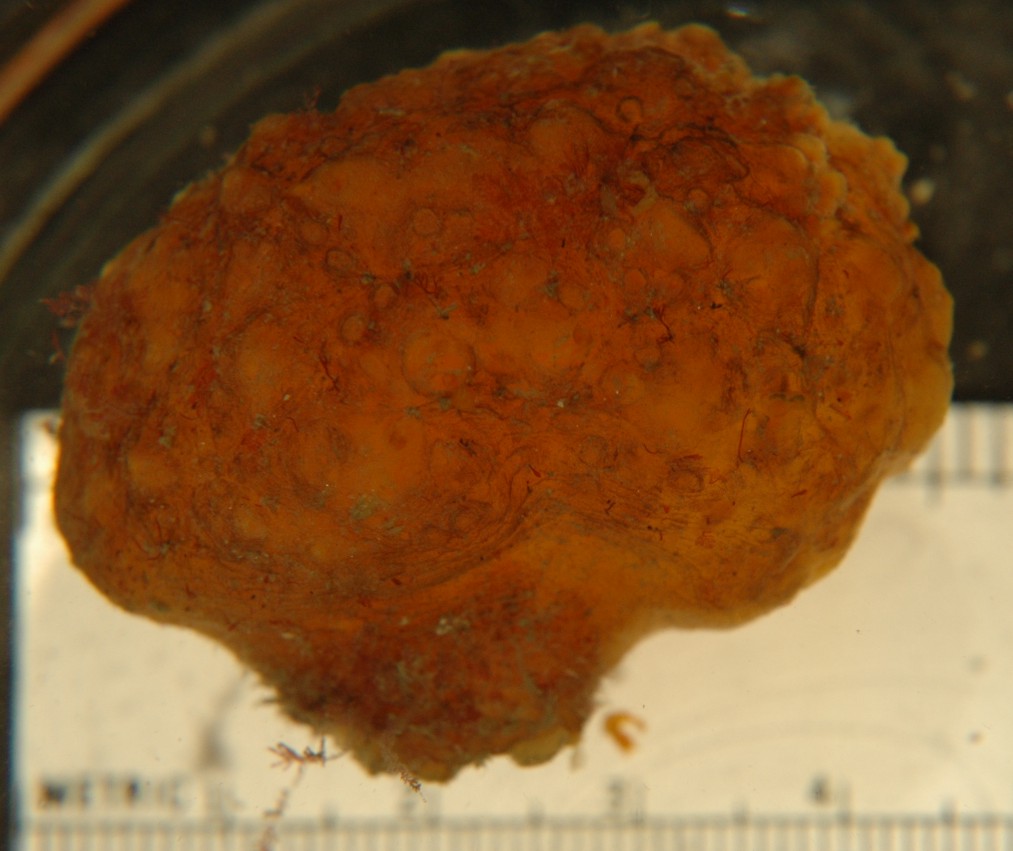Distaplia occidentalis Bancroft, 1899Common name(s): Mushroom ascidian |
|
| Synonyms: |  |
| Phylum Chordata
Subphylym Urochordata Class Ascidiacea Order Enterogona Suborder Aplousobranchia Family Clavelinidae |
|
| Distaplia occidentalis from about 20 m depth, Sares Head, WA. The attachment stalk is at the bottom. | |
| (Photo by: Dave Cowles, July 2006) | |
How to Distinguish from Similar Species: Several species of similar shape are often sand-encrusted and have 5 or more rows of stigmata. Distaplia smithi, which lives on the open coast, is a cluster of leaflike lobes. Of the other common, smooth orange local tunicates, Metandrocarpa taylori is a social ascidian in which individuals live near each other and are often connected with narrow stolons or sheets of tunic but are not enclosed within the same lump of tunic. Cnemidocarpa finmarkiensis is a solitary tunicate with a very smooth, shiny tunic.
Geographical Range: Vancouver Island, Canada to San Diego, CA
Depth Range: Intertidal to 15 m
Habitat: Protected floats and pilings, subtidal on rocks with good current, among surfgrass roots, open coast.
Biology/Natural History:
Spawns April
to late August. Each zooid produces 2-4 sausage-shaped eggs,
which
are retained in a brood pouch of the atrial cavity until the tadpole
larva
stage. Larve are released mainly in the morning.
Hermaphroditic.
| Return to: | |||
| Main Page | Alphabetic Index | Systematic Index | Glossary |
References:
Dichotomous Keys:Flora and Fairbanks, 1966
Kozloff 1987, 1996
Smith and Carlton, 1975
General References:
Carefoot,
1977
Gotshall,
1994
Harbo,
1999
Johnson
and Snook, 1955
Kozloff,
1993
Morris
et al., 1980
Scientific
Articles:
Watanabe, H. and C.C. Lambert,
1973. Larva
release in response to light by the compound ascidians Distaplia
occidentalis and Metandrocarpa
taylori. Biological Bulletin 144:
556-566
Web sites:
General Notes and Observations: Locations, abundances, unusual behaviors:

Each individual has its own separate incurrent (oral) siphon but the
excurrent (buccal) siphon is shared by several adjacent
individuals.
This closeup shows the arrangement of individuals.
Authors and Editors of Page:
Dave Cowles (2006): Created original page